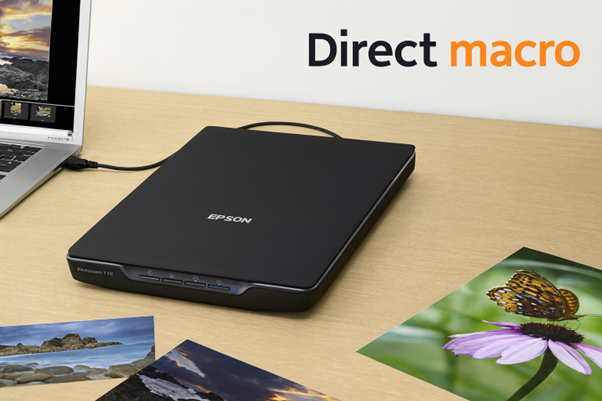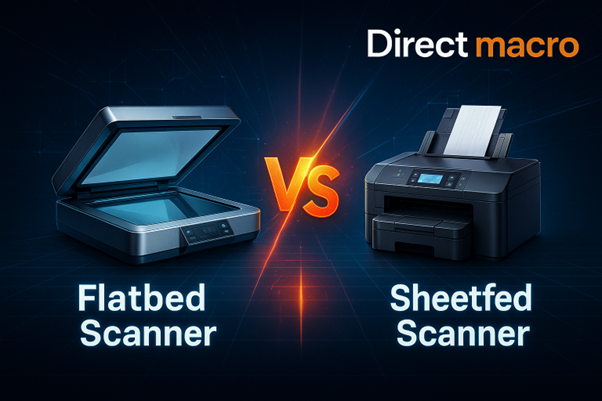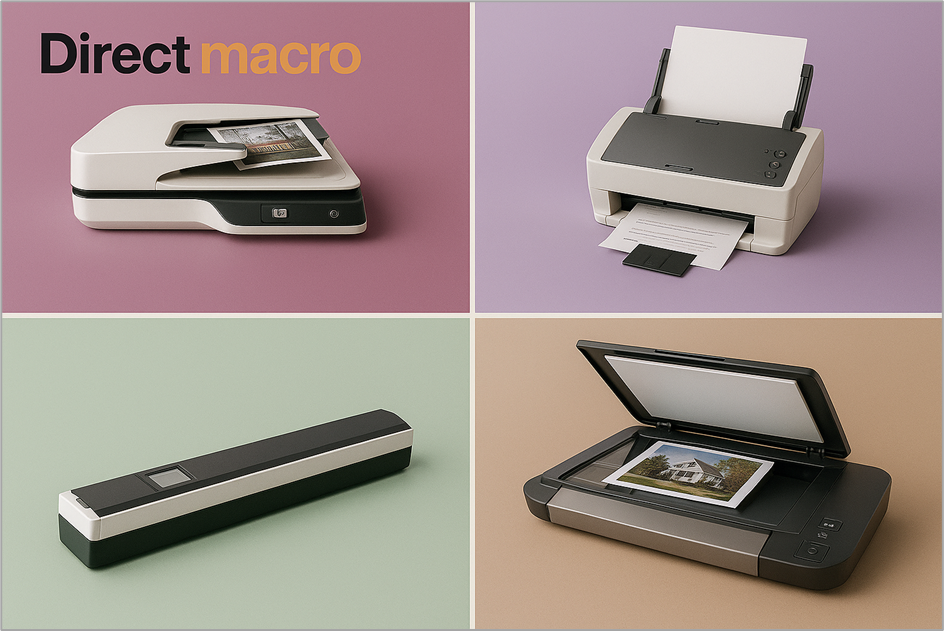Flatbed vs Sheetfed Scanners: Which One Should You Buy?
When it comes to dealing with paperwork or archiving old photographs, choosing the right digitizing tool is the first step to managing your paper-based life. You will mainly come across two primary types of scanners: flatbed scanner and sheetfed scanner. This guide will help you to decide which one you should buy by looking closely at both types of technologies. We will provide a comprehensive scanner comparison guide that considers the core attributes, advantages, and best use cases.
What is Flatbed Scanner?

A flatbed scanner looks like a small photocopier. A flatbed scanner has a glass surface (the platen), which is where items are placed to be scanned. and a lid that closes over it. For the scanning, the document stays still, while a light and a sensor (most often CCD or CIS) move under the glass to take the image of the document. This design is highly adaptable and minimizes the risk of damaging the scanned material.
Advantages of Flatbed Scanner
The flatbed scanner offers a suite of benefits that make it the preferred choice for specific tasks:
- Superior Image Quality and High Resolution
Many flatbed scanners are capable of offering an even higher optical resolution such as 1200 DPI, because of their CCD sensors, which makes them the best scanner for documents, photos, detailed artwork, or anything else that has to be scanned into an archival-grade quality. - Versatility in Scanning Materials
A major flatbed scanner advantage is its ability to scan almost anything that can lie flat, especially for things that might be a little thicker, such as books, magazines, passports, and IDs, or even small 3D objects. - Gentle on Fragile Originals
Because the document does not pass through rollers, there is a small chance of it bending, tearing, or scratching. This makes a flatbed the best option for old, delicate, or vintage photographs, which is a significant flatbed scanner advantage.
Disadvantages of Flatbed Scanner
Despite its quality, the flatbed design also has some drawbacks:
- Slow for Multi Page Jobs
The process of manually placing, scanning, and removing each page making it inefficient for high-volume document scanning and significantly makes it slower for batch scanning. - Bulky Footprint
Flatbed scanners take up a considerable amount of desk space and are generally not portable. - Dust and Smudge Sensitive
The glass platen can collect dust and fingerprints, which can get on the scans, so it needs to be cleaned often.
Use Case of Flatbed Scanners
The flatbed model excels in scenarios where quality and versatility trump speed. It is the go-to machine for:
- Creative Professionals
Using the appropriate adapter, scanning works of art, photographs, slides, and negatives from film media. - Archivists
The process of digitizing historical records that are fragile or priceless, such as old family photographs and newspaper clippings. - Students and Home Users
Scanning the pages of periodicals and books without having to tear them out.
What is Sheetfed Scanner?

A sheetfed scanner, also called a document feeder scanner. It is compact device where you insert a paper in a slot, and a set of rollers automatically moves the paper past a stationary scan head. A lot of these also have an Automatic Document Feeder (ADF), which lets you load multiple sheets of paper in a stack. This is one of the ways to compare flatbed vs. sheet-fed scanners that focuses on speed and efficiency.
Advantages of Sheetfed Scanner
The sheetfed model truly designed for process the large volumes of paper as per your requirement. The primary sheetfed scanner benefits include:
- Extremely Fast Scanning Speed
The Sheetfed scanners have ability to scan dozens of pages per minute (PPM) that makes them incredibly more competent for high-volume tasks on daily basis. - Automatic Document Feeder (ADF)
Sheetfed scanner benefits include the automatic document feeder (ADF) feature, which allows users to load a stack of paper, such as up to hundreds of sheets, at once. This feature provides true batch-scanning automation. - Duplex Scanning
The best thing about the modern sheetfed scanners is that they can perform duplex scanning. It means they can capture both sides of a page in a single pass. This scanning ability doubles their efficiency for two-sided document scans at once. - Compact and Portable
Sheetfed scanners are ideal due to their compact size and portability. Their design is much smaller and lighter than other types of scanners, such as flatbed scanners, which makes them a superlative choice for small offices, home offices, and traveling professionals.
Disadvantages of Sheetfed Scanner
The high speed and compactness of sheetfed scanners come with trade-offs:
- Risk of Damage to Fragile Items
Running delicate or oddly shaped items like old photographs or vintage documents through rollers can cause them to tear or get ruined. That’s why we don’t recommend sheetfed scanners for these types of documents. - Cannot Scan Bound Materials
Because the paper must be loose, they cannot scan pages from books or thick magazines. - Potential for Paper Jams
The automated feeding mechanism can occasionally lead to frustrating paper jams, especially with mixed media or heavily creased paper.
Use Case of Sheetfed Scanner
A sheetfed scanner is purpose-built for high-volume, repetitive document processing. If you’re wondering which scanner type to buy for pure productivity, this is it.
- Business and Office Use
Sheetfed scanners offer scanning benefits for all businesses and offices, such as rapidly digitizing invoices, contracts, legal documents, reports, and client files. - Finance and Accounting
These scanners help you to scan stacks of receipts and business cards for expense reports and record-keeping. These scanners are an excellent option for businesses and office professionals. - Paperless Initiatives
Sheetfed scanners are the ideal choice for professionals who are looking for converting years of collected and gathered paper files into searchable digital archives. These are known as the best scanners for documents in a modern office environment.
Flatbed vs Sheetfed Scanners: Which One Should You Buy?
The choice between a flatbed vs sheetfed scanner boils down entirely to your primary scanning needs.
Comparison Table: Flatbed Vs Sheetfed Scanner
| Feature | Flatbed Scanner | Sheetfed Scanner | Winner (Based on need) |
| Primary Use | High-quality, versatile scans of single items | High-volume, fast scanning of loose documents | Depends on Volume vs. Quality |
| Speed/Productivity | Slow (Manual page change) | Very Fast (Automatic Document Feeder) | Sheetfed |
| Quality/Resolution | Higher (Best for photos, art) | Good (Best for documents) | Flatbed |
| Versatility | Excellent (Books, photos, thick items) | Poor (Only loose sheets) | Flatbed |
| Footprint | Large (Takes up desk space) | Compact/Portable | Sheetfed |
| Damage Risk | Low (Stationary) | High (Rollers can damage paper) | Flatbed |
The best scanner for documents that come in large stacks such as invoices or contracts, is undoubtedly the sheetfed scanner. The flatbed scanner is the superior and safer tool, if your collection is primarily vintage photos, art, or books.
Things You Need to Consider When Buy Scanner
To help you decide which scanner type to buy, consider these technical and practical factors. They are essential for any thorough scanner comparison guide:
- Scanning Volume
Always check scanning volume before making purchase and think, how many pages will you scan daily? A flatbed is fine for 10-20 pages a week, but anything over 50 requires the speed and efficiency of a sheetfed model (often 40-60+ PPM). - Optical Resolution (DPI)
300 DPI is perfectly fine for most documents. However, when scanning a professional photo or artwork, you need a scanner with an optical resolution of 1200 DPI or higher to achieve the best results. So, a flatbed scanner advantages you in achieving your desired goal. - Duplexing
If most of your documents are two-sided and require duplex scanning, then make sure that your sheetfed scanner model has a true dual scanning feature in a single pass. It is a vital sheetfed scanner benefit for efficiency. It helps you to choose the right device according to your needs. - Software and OCR
Good Optical Character Recognition (OCR) software is non-negotiable, as it converts the scanned image into searchable and editable text. - Connectivity and Portability
You need Wi-Fi connectivity to scan to a cloud service, or a portable, USB-powered model for travel.
Final Thoughts
You need to choose between versatility and quality, as well as speed and volume when choosing between a flatbed vs sheetfed scanner. If you are a home user who digitizes receipts, letters, and photos, then a plain flatbed scanner, or an all-in-one printer with a flatbed, will probably be enough. A sheetfed scanner will be indispensable for a high-traffic home office or small business that aspires to be paperless because of its speed and efficiency. For an estimate of productivity and workflow, use this scanner comparison guide to evaluate your workflow and make the choice that maximize your productivity.
To receive prompt and dependable assistance with all of your computer parts needs, call us at (855)-483-7810. For bulk order inquiries, please complete a submission form.
FAQs
- Can I scan a book with a sheetfed scanner?
No. Sheetfed scanners require loose sheets of paper. You must use a flatbed scanner to place each page on the glass to scan a book without damaging it, - Are sheetfed scanners good for photos?
Generally, no. While some modern models claim to handle photos, the roller mechanism poses a significant risk of scratching or damaging vintage or delicate photographs. The high-resolution flatbed scanner advantage makes it the better choice. - What is a duplex scanner?
A duplex scanner, a common feature with sheetfed scanner benefits, can scan both sides of a two-sided document automatically in a single pass, greatly speeding up the process for multi-page documents. - Why do flatbed scanners have a higher DPI?
Flatbed vs sheetfed scanner resolution difference stems from the technology. Flatbeds are designed for detailed image capture (like photos), often using superior CCD technology to achieve a higher optical resolution, which makes them the best scanner for documents that are images. - What is the main benefit of a sheetfed scanner?
The main sheetfed scanner benefit is its speed and automation for batch-scanning documents through the use of an Automatic Document Feeder (ADF).
you might also like
Do you need advice on buying or selling hardware? Fill out the form and we will return.

Sales & Support
(855) 483-7810
We respond within 48 hours on all weekdays
Opening hours
Monday to thursday: 08.30-16.30
Friday: 08.30-15.30







